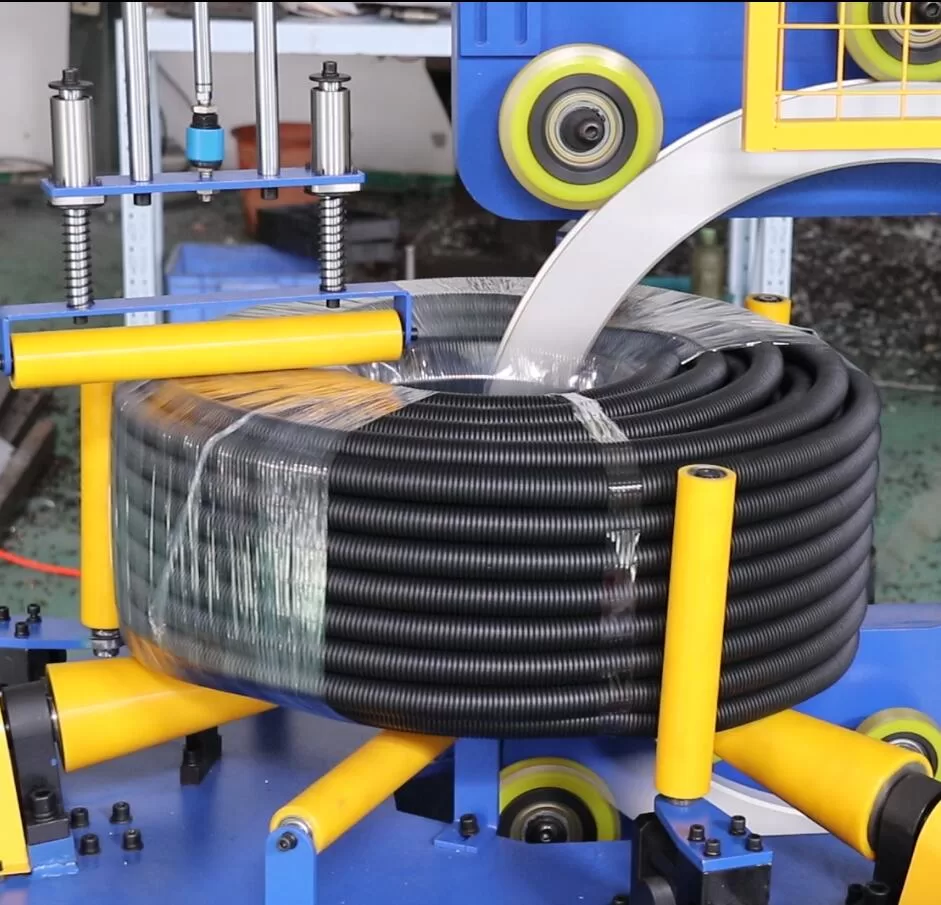Optimizing Hydraulic Hose Handling: The Role of Automatic Coiling Machines
Handling large volumes of hydraulic hose, particularly types reinforced with multiple high-tensile steel wires, presents significant challenges in manufacturing and fabrication environments. Manual coiling is labor-intensive, inconsistent, and can pose safety risks. Automatic hose coiling machines offer a robust solution to streamline this critical process, enhancing efficiency and product quality for hoses ranging in OD from approximately 13.00mm to 50.00mm.

Understanding How Automatic Hose Coiling Machines Function
These automated systems are designed to take extruded or cut lengths of hydraulic hose and wind them into neat, manageable coils. While designs vary, the core process typically involves:
- Hose Infeed: The hose is guided into the machine, often from an extruder line or payoff stand.
- Measuring: Integrated sensors or measuring wheels ensure precise hose lengths for each coil, minimizing waste.
- Coiling: A rotating drum or coiling head winds the hose into a specified diameter and configuration. Tension control systems are crucial here to prevent hose damage and ensure a tightly wound, stable coil.
- Cutting (Optional): Some systems incorporate an automatic cutting mechanism once the desired length is reached.
- Securing: The finished coil is often automatically secured using integrated strapping or tying units, preparing it for downstream handling or packaging.
Key Operational Benefits for Hydraulic Hose Coiling
Integrating an automatic hose coiling machine into the production line yields several tangible advantages:
- Enhanced Efficiency and Throughput: Automation significantly reduces the time required to coil each length of hose compared to manual methods, directly increasing overall production output.
- Improved Coil Consistency: Machines produce uniform coils with consistent tension, diameter, and length, which simplifies subsequent packaging, storage, and handling processes.
- Increased Operator Safety: Automating the coiling process minimizes direct operator interaction with moving machinery and heavy hoses, reducing the risk of repetitive strain injuries and accidents.
- Reduced Material Waste: Precise length measurement and controlled coiling prevent kinks, twists, or damage often associated with manual handling, leading to less scrap.
- Streamlined Handling: Tightly wound, secured coils are easier and safer to move, whether manually or via automated systems like conveyors.
Essential Features and Customization Considerations
Selecting the right automatic hose coiling machine requires careful consideration of specific operational needs:
- Hose Specifications: Ensure the machine can handle the required range of hose diameters (e.g., 13.00mm - 50.00mm OD), types (hydraulic rubber, steel wire reinforcement), and flexibility characteristics.
- Coil Dimensions: Verify the machine's capability to produce the desired inner/outer coil diameters and overall coil weight.
- Control System: Look for intuitive controls (often PLC-based) that allow for easy adjustment of parameters like hose length, coiling speed, and tension. Integration capabilities with existing line controls can be beneficial.
- Tension Management: A reliable and adjustable tension control system is critical for protecting the hose structure while achieving a stable coil.
- Automation Level: Determine the required level of automation, from basic coiling to fully integrated systems incorporating cutting, strapping, or wrapping.

hose wrapping Integrating Coiling Systems with Conveyors and Packaging
For maximum efficiency, automatic hose coiling machines are often integrated into a larger production flow. Conveyor systems play a vital role in transporting finished coils away from the coiler to subsequent stations. This reduces manual handling further and facilitates a continuous workflow towards final automatic coiling and packing machines, such as stretch wrapping or palletizing units. Properly designing this interface ensures a seamless transition from coiling to final packaging.
Conclusion
Automatic hose coiling machines represent a significant technological advancement for manufacturers and fabricators dealing with hydraulic hose. By automating a traditionally manual and demanding process, these systems deliver substantial improvements in production speed, coil quality, operational safety, and material efficiency. When properly specified and integrated, they become a cornerstone of optimized hydraulic hose handling and packaging operations, contributing to a more streamlined and productive workflow.
